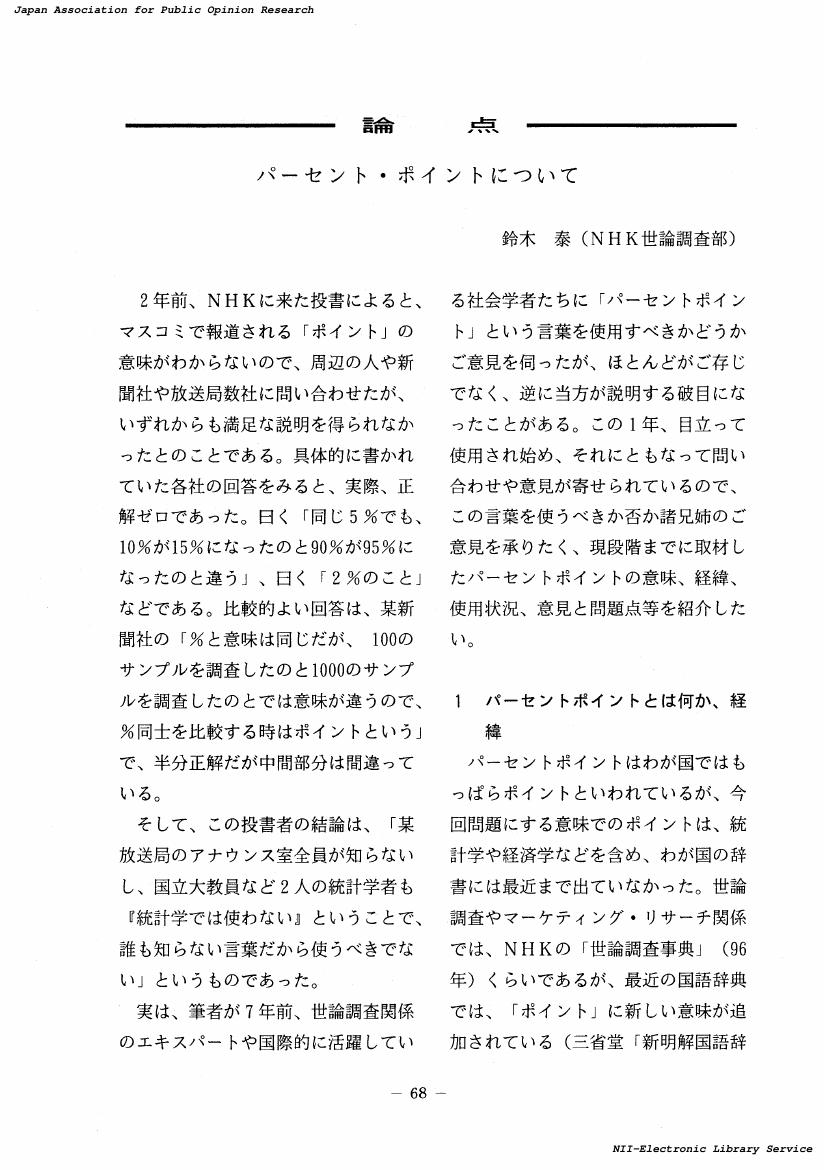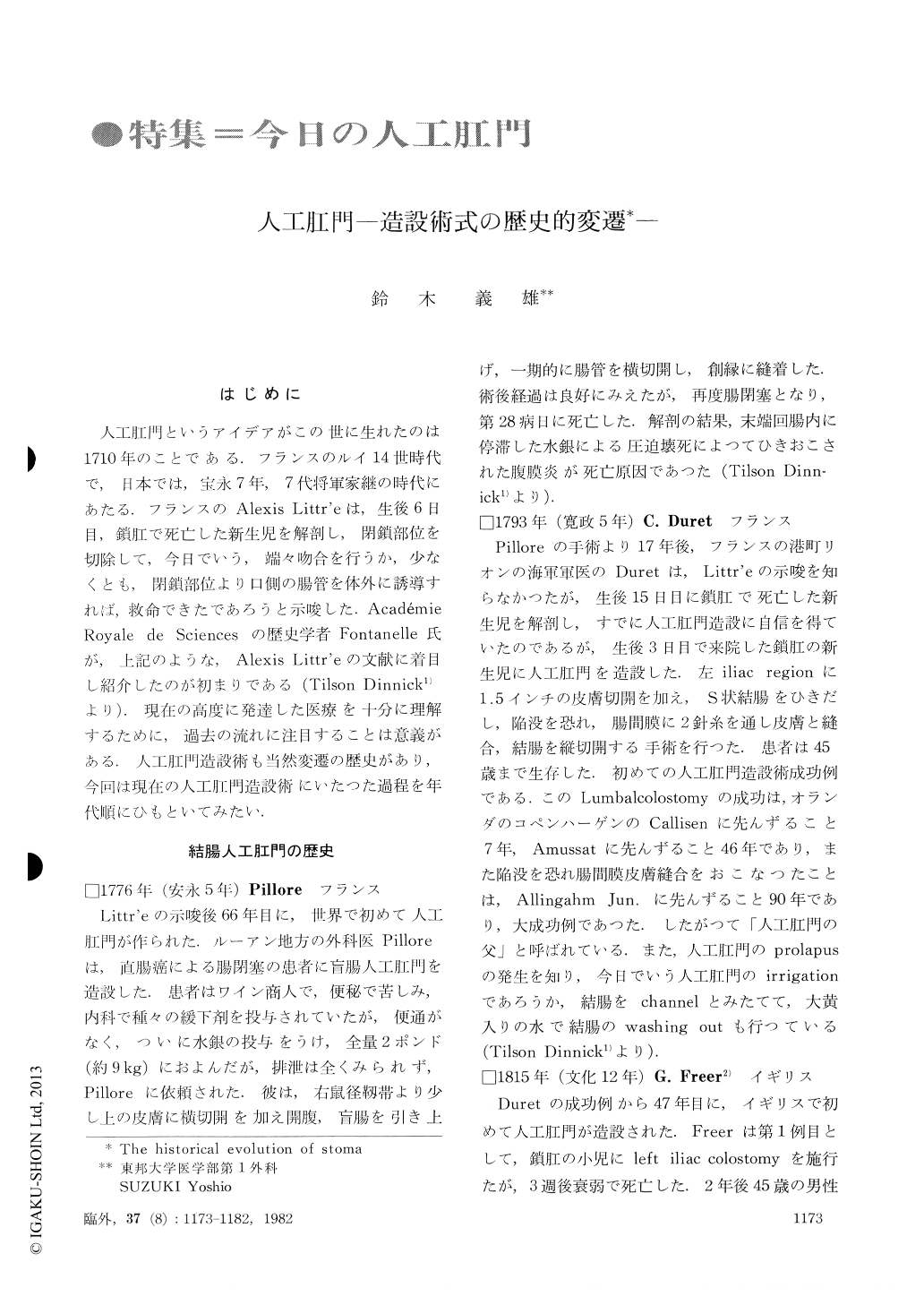2 0 0 0 OA 阪本ちづみ先生 追悼文
- 著者
- 鈴木 豊
- 出版者
- 法政大学多摩論集編集委員会
- 雑誌
- 多摩論集 = 多摩論集 (ISSN:09112030)
- 巻号頁・発行日
- vol.34, no.別冊, pp.1-3, 2018-03
2 0 0 0 消化管(胃)内アルコール発酵による酩酊症
- 著者
- 榊山 悠紀士 白松 幸爾 戸塚 守夫 鈴木 彰
- 出版者
- 日本臨床外科学会
- 雑誌
- 日本臨床外科医学会雑誌 (ISSN:03869776)
- 巻号頁・発行日
- vol.32, no.4, pp.434-438, 1971
- 被引用文献数
- 1
2 0 0 0 IR ポストモダン状況下におけるグローバル人材育成者の教育観 : 幻想の希望から不可視の希望へ
- 著者
- 鈴木 繁夫 Suzuki Shigeo
- 出版者
- 名古屋大学人文学研究科
- 雑誌
- 名古屋大学人文学研究論集 (ISSN:2433233X)
- 巻号頁・発行日
- no.2, pp.65-88, 2019-03-31
A positive attitude toward life, particularly learned optimism, has been explained in the field of positive psychology as a major key to developing a fruitful life of our own. Hope theory, a branch of the psychology, affirms that we should hold a positive outlook even under negative circumstances, but warns against embracing excessively biased illusions insofar as they may undermine practical and resourceful ways of attaining goals. The theory encourages critical thinking, viewed as indispensable for assessing circumstances and events we encounter. Many college educators who are motivated to produce globally competent students seem to be possessed with heavily biased illusions about negative side-effects of global capitalism, entranced by the idea that their ultimate mission is to furnish students with major skills required to survive in the globalized world. Another group of highly optimistic educators, disenchanted with addiction to economic growth, privilege the importance of quality of life in motivating students to reconstitute their identity as a unique individual amid the uniformity brought by globalization. Recent research, however, shows that Japanese students' mindsets and behaviors have become more dehumanized or "animalized" in the sense that they are unable to look beyond the present moment and immediate circumstances. Symbolic or virtual reality has superseded what used to be considered real or hard facts, replacing students' perceptions and sense of reality with those more akin to animals. In this postmodern condition, educators at least ought to choose a group of students who awaken from a weakness of the will immersed in pleasant illusions and help them awaken to the hope of "being integrated into the universal order" (Gabriel Marcel). Educationalists need to instill a belief within students that their morals and behavior are guided by their natural connections with "the order."
- 著者
- 三田 佳子 鈴木 亮
- 出版者
- 日経BP社
- 雑誌
- 日経マネー (ISSN:09119361)
- 巻号頁・発行日
- no.341, pp.92-95, 2011-04
もう50年? という感じですね。この仕事、嫌いではなかったけど、気がついたら半世紀もやってしまった。驚きですね。それと同時に、もう逃げられない、あとはもう、命ある限り最後まで究めるしかない、というのが実感です。──50年間に転機はありましたか。 デビューから30年間くらいは、「女優の道は獣の道」というイメージがあったんです。
2 0 0 0 OA 清・ビルマ関係
- 著者
- 鈴木 中正
- 出版者
- Japan Society for Southeast Asian Studies
- 雑誌
- 東南アジア -歴史と文化- (ISSN:03869040)
- 巻号頁・発行日
- vol.1981, no.10, pp.3-16, 1981-06-30 (Released:2010-03-16)
Because the Chinese Ch'ing Dynasty deemed Burma a troublemaker in the Southeastern border area of the province of Yunnan, it sent four successive expeditions to Burma during the years from 1766 to 1790. The Shan states on the borders had long been sending tribute to the Burmese court of Ava but the practice was disrupted due to the disorder in Burma caused by the dynastic alternation of the mid-eighteenth century. The newly established Konbaung dynasty claimed their right to collect tribute from the Shan states and while carring on a campaign in Ayuthaya, Siam (1764-67). The Ch'ing emperor thought it necessary to punish and expel the marauders at their borders. The Ch'ing at the zenith of its power mobilized all its resources to chastise Burma but the new dynasty in Burma made every effort to withstand the invaders.The last Ch'ing expeditionary army evacuated Burma at the end of 1769, after concluding a truce agreement on reciprocal restitution of the war captives and surrenders. The Ch'en-lung emperor, however, never consented to turn over the princes of the Shan states who had surrendered to the Ch'ing side, thus putting the border area in a state of severe tension. But a rebellion occured in the province of Sze-ch'uan in 1771 diverting the emperor's concern from Burma and his resentment was gradually dissipated.For the purpose of normalizing relations with the Ch'ing, Burma attempted to negotiate twice, in 1772 and in 1777. Their effort, however, was in vain because the Ch'ing emperor continued to demand from Burma, unilateral restitution of war captives. Among the Shan rulers on the borders, however, there emerged a move to normalize the relations between their two powerful neighbors in order to bring about trade relations which profitted the border states. In 1787, the prince of Keng Ma, a Shan state on the Yunnan side, sent a friendship mission to Burma disguised as a Ch'ing court mission: Burma sent a return mission to Peking in 1788. This brought the two countries' relations nearly to completion. In 1790, the prince of Bhamo on the Burmese side, sent a mission to Peking on his own initiative, unnoticed by the court of Burma. Thus the long disrupted Sino-Burmese relations came to be normalized despite the fact that the Ch'ing court declared Burma as its vassal state and Burma had no intention of accepting such a status
- 著者
- 安田 万里子 中川 一美 中川 高志 鈴木 絢子 髙橋 麻美 梶川 歩美 西舘 美音子 野老 由美子 松澤 範子 齋藤 晃 森山 優
- 出版者
- 一般社団法人 日本総合健診医学会
- 雑誌
- 日健診誌 (ISSN:13470086)
- 巻号頁・発行日
- vol.42, no.3, pp.385-391, 2015
- 被引用文献数
- 3
日本では、禁煙治療として2006年からニコチン依存管理料が保険適用となり、2008年から禁煙補助薬であるバレニクリン(チャンピックス)が保険適用となった。喫煙率低下に向け、禁煙治療も大きく影響しており、定期的な禁煙治療の評価を行い、有効な禁煙治療を行っていく必要がある。今回我々は、2009年10月1日から2012年3月31日までに禁煙外来にて治療を行った130名(男性97名、女性33名)を対象に、禁煙成功群と禁煙失敗群に分類し、年齢、性別、ブリンクマン指数、TDS、初診時CO濃度値について両者の差異を比較した。有意差が認められたものはブリンクマン指数のみであり、禁煙成功群の方が高い値となった。<br> また、禁煙治療の5回受診を完了した者(5回通院者)は、禁煙成功群93名のうち69名であり、禁煙失敗群では、37名のうち5名であった。禁煙成功率と通院中断の有無に有意差が認められ、禁煙治療5回のプログラムを最後まで通院することが、禁煙の成功を有意に高めていた。<br> 禁煙成功群を対象にし、計5回の禁煙治療終了時点で4週間以上の禁煙に成功している者を完全成功群と定義し、計5回の禁煙治療を中止した者のうち、中断時期から4週間以上の禁煙に成功している者を中断成功群と定義した。禁煙成功群93名のうち、完全成功群は69名、中断成功群は24名であった。完全成功群と中断成功群の1年後の禁煙継続率は完全成功群が73.1%に対し、中断成功群は65.2%であったが、これらの有意差は認められなかった。しかし、2年後の禁煙継続率を見ると、完全成功群が51.1%、中断成功群は31.7%であり、長期的に見ると完全成功群の方が高い値であった。<br> これらのことから、禁煙治療プログラム5回全てに来院することが禁煙治療成功に繋がりやすく、また、長期的な禁煙継続にも影響していると考えられた。
2 0 0 0 OA 黄色ブドウ球菌敗血症の研究
- 著者
- 島田 馨 岡 慎一 鈴木 宏男 稲松 孝思 浦山 京子
- 出版者
- 一般社団法人 日本感染症学会
- 雑誌
- 感染症学雑誌 (ISSN:03875911)
- 巻号頁・発行日
- vol.59, no.5, pp.459-463, 1985-05-20 (Released:2011-09-07)
- 参考文献数
- 11
- 被引用文献数
- 5 3
東京都養育院付属病院の黄色ブ菌敗血症は1973~79年までは年間2~9例であったが, 1980~83年は年間11~20例と増加した. この血液から分離された黄色ブ菌に対するDMPPCとCEZのMICを測定すると, 1977年以前の分離株はすべてDMPPCとCEZに感性であったが, 1980年以降分離した63株中39株が両者に耐性をしめした. メチシリン・セフェム感性の黄色ブ菌敗血症は1973~83年の間, とくに増加していないが, これにメチシリン・セフェム耐性黄色ブ菌敗血症の加わって, 1980年以降の黄色ブ菌敗血症が増加したと解された. メチシリン・セフェム耐性黄色ブ菌敗血症例は, メチシリン・セフェム感性黄色ブ菌敗血症例に比して低蛋白血症が多く, また発症前2週以内にβ-lactam剤を使用された例が有意に多かった (p<0.01).
2 0 0 0 昭和二年の泉鏡花 : 「河伯令嬢」「卵塔場の天女」の小説機構
- 著者
- 鈴木 啓子
- 出版者
- 明治書院
- 雑誌
- 国語と国文学 (ISSN:03873110)
- 巻号頁・発行日
- vol.95, no.12, pp.3-20, 2018-12
2 0 0 0 IR 社会理論における観察概念から見たメタファーの機能
- 著者
- 鈴木 純一
- 出版者
- 北海道大学大学院メディア・コミュニケーション研究院
- 雑誌
- メディア・コミュニケーション研究 (ISSN:18825303)
- 巻号頁・発行日
- no.72, pp.75-93, 2019-03-20
The purpose of this thesis is to examine a metaphor from the angle of the observation. That way, the feature as the function of the metaphor will be brought into shaper focus. A metaphor involves "cutoff" and "connection" processes at the same time while duplicating the meaning of the expression. In other words, a metaphor contains two contradictory elements at the same time. This article analyzes the function of medium of the metaphor from the perspective of social theory. The thesis also argues that paradoxes and tautologies, etc. are a fundamental principle of a metaphor by quoting Luhmann's theory.
2 0 0 0 IR 謝罪文に付与された顔文字が受け手の感情に与える効果
- 著者
- 荒川 歩 鈴木 直人 アラカワ アユム スズキ ナオト Arakawa Ayumu Suzuki Naoto
- 出版者
- 大阪大学大学院人間科学研究科対人社会心理学研究室
- 雑誌
- 対人社会心理学研究 (ISSN:13462857)
- 巻号頁・発行日
- vol.4, pp.135-140, 2004
2 0 0 0 OA 食品の持つ抗菌性を調べる実験の教材化
- 著者
- 高橋 大輔 鈴木 隆 加藤 良一
- 出版者
- 山形大学
- 雑誌
- 山形大学紀要. 教育科学 = Bulletin of Yamagata University. Educational Science
- 巻号頁・発行日
- vol.15, no.1, pp.1-20, 2010-02-15
要旨 : 植物性食品の抗菌性を簡便に調べることができる実験教材として、(A)YEB寒天培地又はPYG寒天培地の中央に直径10mmの穴を開け、腐葉土からの2倍希釈の上澄み液を培地表面に0.5ml塗布し、その中央の穴に抗菌性食品を約0.3g入れ、それらをシャーレで24時間培養する方法、(B)YEB寒天培地又はPYG寒天培地の中央に直径10mmの穴を開け、納豆からの5倍希釈の上澄み液を培地表面に0.5ml塗布し、その中央の穴に抗菌性食品を約0.3g入れ、それらをシャーレで24時間培養する方法、及び(C)6枚切り又は8枚切りの食パンの耳の部分を切り落とし、さらに1枚の食パンをほぼ均等に4つの四角形の切片にし、その切片の片面のみ腐葉土からの5倍希釈の濾液に浸し、その切片の中央に約0.3gの抗菌性食品を置き、それらを密封容器で5日間培養する方法の3つが簡便で分かりやすいものとして示された。
2 0 0 0 OA パーセント・ポイントについて(論点)
- 著者
- 鈴木 泰
- 出版者
- 公益財団法人 日本世論調査協会
- 雑誌
- 日本世論調査協会報「よろん」 (ISSN:21894531)
- 巻号頁・発行日
- vol.79, pp.68-76, 1997-03-31 (Released:2017-03-31)
- 著者
- 鈴木 宏枝
- 出版者
- 青山学院女子短期大学総合文化研究所
- 雑誌
- 青山学院女子短期大学総合文化研究所年報 (ISSN:09195939)
- 巻号頁・発行日
- no.24, pp.75-89, 2016-12
2 0 0 0 OA 改元を通してみた天皇 : 「昭和」改元と「平成」改元の比較分析
- 著者
- 鈴木 洋仁
- 出版者
- 国際日本文化研究センター
- 雑誌
- 日本研究 = NIHON KENKYŪ
- 巻号頁・発行日
- vol.54, pp.79-104, 2017-01-31
本稿は、「平成」改元にあたって、小渕恵三官房長官(当時)が行った記者会見を分析することによって、大日本帝国憲法(1889)と日本国憲法(1947)における天皇の位置づけの相違を分析するものである。具体的には、改元を天皇による「時間支配」の究極の形式と定義したうえで、「平成」改元における、(1)政治性、(2)公共性、(3)メディア性という3点の違いを抽出する。なぜなら、日本国憲法においても、大日本帝国憲法と同様、「一世一元」の原則が法律で定められているからである。
2 0 0 0 人間風船
- 著者
- 神谷 知樹 青木 亮裕 櫻井 慎太郎 佐藤 圭一郎 鈴木 諄 山本 拓弥
- 出版者
- 特定非営利活動法人 日本バーチャルリアリティ学会
- 雑誌
- 第21回日本バーチャルリアリティ学会大会
- 巻号頁・発行日
- 2016-09-09
2 0 0 0 ムラサキツメクサによるアカタテハ幼虫の飼育
- 著者
- 鈴木 光
- 出版者
- 日本鱗翅学会
- 雑誌
- 蝶と蛾 (ISSN:00240974)
- 巻号頁・発行日
- vol.66, no.2, pp.45-57, 2015-10-27
アカタテハ幼虫をムラサキツメクサで室内飼育し,その生育状況を調べた.野外で捕獲したアカタテハ(メス)から卵を得て,孵化した幼虫をマオで飼育し,1〜5齢に達した幼虫を順次ムラサキツメクサ食に移行させて,その生育状況をマオ食幼虫(対照群)と比較し観察した.対照群幼虫は,1〜5齢のどの段階からムラサキツメクサ食に移行させても蛹・成虫にまで生育できたが,生存率は低く,ムラサキツメクサ食の期間が長いほど幼虫期間が長く,蛹化率も蛹の羽化率も低かった.蛹重と蛹長を比較すると,ムラサキツメクサ食群は対照群に比べ小型で,成虫の前翅長も短かったが,成虫の翅の形態や翅紋に異常は認められなかった.以上の結果から,ムラサキツメクサは,飼育環境下においては,アカタテハ幼虫の代用食になり得るが,好適な食草ではないことが示唆された.
2 0 0 0 OA 摂関期における左右近衛府の内裏夜行と宿直
- 著者
- 鈴木 裕之
- 出版者
- 公益財団法人 史学会
- 雑誌
- 史学雑誌 (ISSN:00182478)
- 巻号頁・発行日
- vol.125, no.6, pp.37-62, 2016 (Released:2018-10-05)
本稿の目的は、内裏の夜間警備(夜行・宿直)の分析から、摂関期における左右近衛府の機能を検討することである。律令制以来、衛府は内裏警備を主たる職掌とした。夜間の警備も同じく規定されていた。延喜式段階でも、その職掌は継承された。本稿の問題意識は、このような内裏の夜間警備が摂関期(一一世紀)に機能していたか、あるいは貴族に認識されていたかという点にある。従来の研究で否定的に理解されてきた摂関期の左右近衛府の治安維持機能について、内裏夜行・宿直の観点から再検討した。 まず、延喜式の夜行・宿衛規定の分析を起点とした。夜行に関する諸規定から、六衛府すべてが内裏・大内裏の夜行に関与していることを指摘した。内裏夜行の検討が、摂関期の左右近衛府の性格を知るうえで有効であると判断した。また、宿衛は考第・昇進の条件として考えられていた。内裏夜行・宿衛の実態史料の分析から、その日常性が確認できた。 次に、一一世紀の左右近衛府の内裏夜行・宿直を考えるため、行事書・儀式書から次第を確認し、古記録から実態を検討した。その結果、摂関期における左右近衛府の内裏夜行・宿直の日常性が明らかとなり、貴族が治安維持組織たる左右近衛府を認識していたことを指摘した。 最後に、内裏夜行・宿直の有効性を補足する論点として、内裏火災における左右近衛府の活動に着目した。摂関期の内裏火災において、消火活動と予防組織としての左右近衛府の姿がみられた。消火・予防という活動の背景には、内裏夜行・宿直の有効性とそれに付随する貴族認識があると考えた。 従来の研究で否定的に理解されてきた左右近衛府の治安維持機能を、内裏の夜間警備を通じてみることで、肯定的に捉えようとしたのが本稿である。儀式関与・芸能・摂関家への奉仕など、様々な存在形態が認められる左右近衛府であるが、本来的な治安維持組織としての姿もその一つとして認めるべきであると結論づけた。
2 0 0 0 人工肛門—造設術式の歴史的変遷
- 著者
- 鈴木 義雄
- 出版者
- 医学書院
- 雑誌
- 臨床外科 (ISSN:03869857)
- 巻号頁・発行日
- vol.37, no.8, pp.1173-1182, 1982-08-20
はじめに 人工肛門というアイデアがこの世に生れたのは1710年のことである.フランスのルイ14世時代で,日本では,宝永7年,7代将軍家継の時代にあたる.フランスのAlexis Littr'eは,生後6日目,鎖肛で死亡した新生児を解剖し,閉鎖部位を切除して,今日でいう,端々吻合を行うか,少なくとも,閉鎖部位より口側の腸管を体外に誘導すれば,救命できたであろうと示唆した.Académie Royale de Sciencesの歴史学者Fontanelle氏が,上記のような,Alexis Littr'eの文献に着目し紹介したのが初まりである(Tilson Dinnick1)より).現在の高度に発達した医療を十分に理解するために,過去の流れに注目することは意義がある.人工肛門造設術も当然変遷の歴史があり,今回は現在の人工肛門造設術にいたつた過程を年代順にひもといてみたい.


